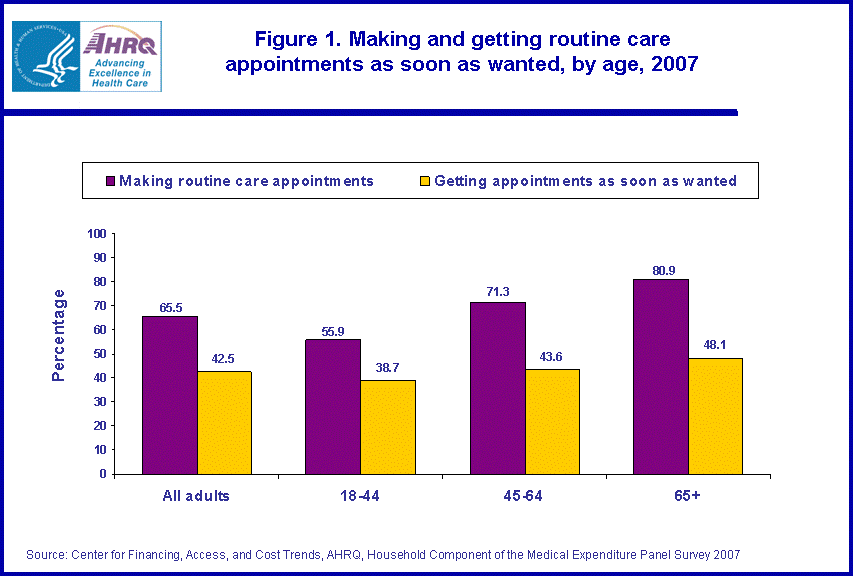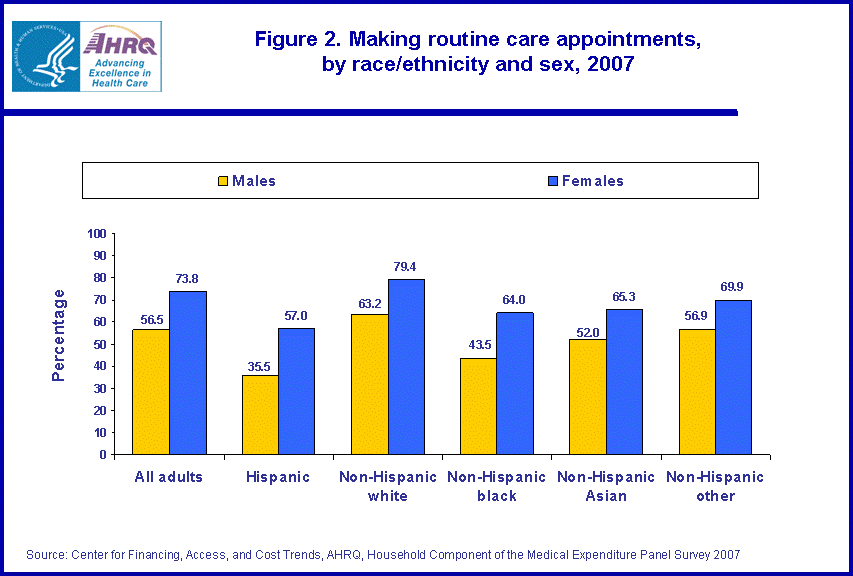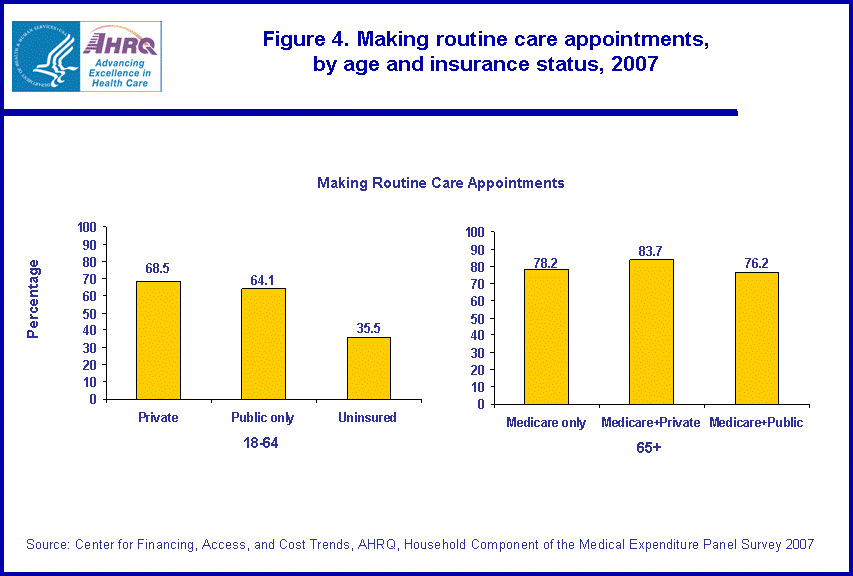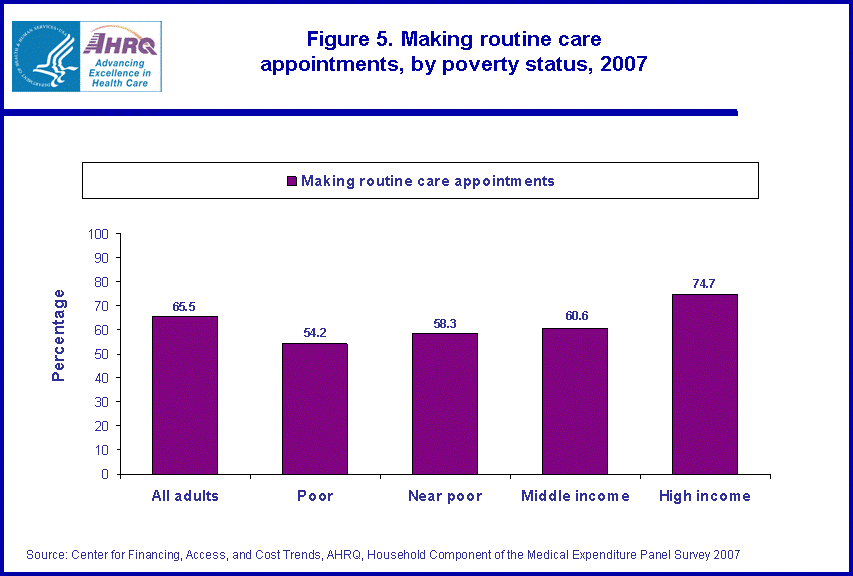
|
|
Font Size:
|
||||
|
|
|
|
||||
STATISTICAL BRIEF #284:
Getting Routine Care, U.S. Adult Noninstitutionalized Population, 2007
Highlights
- Two-thirds (65.5 percent) of adults reported making an appointment with a health care professional for routine care in the last 12 months.
- Of those who made an appointment for a routine care visit, 42.5 percent reported that they always got an appointment as soon as they wanted.
- A higher percentage of females reported making routine health care appointments compared with males (73.8 percent versus 56.5 percent).
- Three-fourths of those who were in fair or poor health reported making a routine care appointment in last 12 months.
- Just over half of those who were in poor families made a routine care appointment in the last 12 months.
Introduction
The most common reason for visiting a health care provider is for routine care or a yearly check-up. Routine care is typically defined as a visit with a doctor or other health professional for assessing overall health, usually not prompted by a specific illness or complaint. Routine care appointments for this analysis have been defined as any appointment with a health care professional for care that was not needed right away.
This Statistical Brief analyzes data from the Medical Expenditure Panel Survey, Household Component's (MEPS-HC) Self-Administered Questionnaire to estimate how often adults make appointments for routine care only; and how often they get these appointments as soon as they want them. All differences discussed in the text are statistically significant at the 0.05 level or better.
Findings
In 2007, almost two-thirds (65.5 percent) of adults reported making an appointment with a health care professional for a routine visit in the last 12 months (figure 1). Adults who were 65 and older made routine health care appointments at a higher rate than those who were 18-44 (80.9 percent versus 55.9 percent). Of those adults who reported making appointments, 42.5 percent reported that they always got an appointment as soon as they wanted it. A higher percentage of those 65 and older reported getting appointments as soon as they wanted compared to those ages 18-44 (48.1 percent versus 38.7 percent).
A higher percentage of females reported making routine health care appointments compared with males (73.8 percent versus 56.5 percent). White non-Hispanic men reported making routine care appointments at a higher rate than non-Hispanic black or Hispanic men (63.2 percent versus 43.5 percent and 35.5 percent) (figure 2).
Adults who were in fair or poor health reported making appointments for routine care at a higher rate than those who reported themselves to be in excellent health (76.4 percent versus 51.7 percent) (figure 3).
Among persons ages 18-64, those with private insurance reported making routine care appointments at a rate which was almost double the rate of those who were uninsured (68.5 percent versus 35.5 percent) (figure 4).
A little over half (54.2 percent) of those who were poor made routine care appointments within last 12 months compared with three-fourths (74.7 percent) of those who were high income earners (figure 5).
Data Source
The estimates shown in this Statistical Brief are drawn from analyses conducted by the MEPS staff from the following public use file, MEPS HC-107: 2007 Full Year Population Characteristics Data File using questions from the SAQ (Self-Administered Questionnaire).
Definitions
Routine care appointments
Questions about adults' need for making and getting appointments for routine care are asked annually in the MEPS adult self-administered questionnaire. These questions were taken from health plan version of Consumer Assessment of Healthcare Providers and Systems (CAHPS®), an AHRQ-sponsored family of survey instruments designed to measure experiences with care from the consumer s perspective. The questions are:
A health provider could be a general doctor, a specialist doctor, a nurse practitioner, a physician assistant, a nurse, or anyone else you would see for health care. In the last 12 months, not counting the times you needed health care right away, did you make any appointments with a doctor or other health provider for health care?
If yes: In the last 12 months, not counting the times you needed health care right away, how often did you get an appointment for health care as soon as you wanted? Never, Sometimes, Usually, Always
More information about CAHPS® can be obtained through the CAHPS® Web site (www.cahps.ahrq.gov).
Health status
The question about adults' health was self-reported in the MEPS adult self-administered questionnaire. The question asks: In general, would you say your health is: Excellent, Very good, Good, Fair, Poor?
Poverty status
Four income groups are defined based on the percentage of the poverty line for total family income, adjusted for family size and composition. Five categories were used: poor/negative (less than 100 percent of the poverty line), Near Poor (100-199 percent of the poverty line), middle (200-299 percent of the poverty line) and high (greater than 400 percent of the poverty line) in the year of the data collection.
Health insurance status
Individuals under age 65 were classified in the following three insurance categories, based on household responses to health insurance status questions:
- Any private health insurance: Individuals who, at any time during the year, had insurance that provides coverage for hospital and physician care (other than Medicare, Medicaid, or other public hospital/physician coverage) were classified as having private insurance. Coverage by TRICARE (Armed Forces-related coverage) was also included as private health insurance. Insurance that provides coverage for a single service only, such as dental or vision coverage, was not included.
- Public coverage only: Individuals were considered to have public coverage only if they met both of the following criteria: 1) they were not covered by private insurance at any time during the year, and 2) they were covered by one of the following public programs at any point during the year: Medicare, Medicaid, or other public hospital/physician coverage.
- Uninsured: The uninsured were defined as people not covered by private hospital/physician insurance, Medicare, TRICARE, Medicaid, or other public hospital/physician programs at any time during the entire year or period of eligibility for the survey.
- Medicare only: Individuals who, at any time during the year, were covered by Medicare. This classification also includes a small number of persons ages 65 and over who did not report Medicare coverage.
- Medicare plus private (including TRICARE): Individuals who, at any time during the year, were covered by a combination of Medicare, TRICARE, or private insurance.
- Medicare plus other public coverage: Individuals who, at any time during the year, were covered by Medicare in addition to some other type of public insurance.
Classification by race and ethnicity was based on information reported for each family member. Respondents were asked if each family member's race was best described as American Indian, Alaska Native, Asian or Pacific Islander, black, white, or other. They also were asked if each family member's main national origin or ancestry was Puerto Rican; Cuban; Mexican, Mexicano, Mexican American, or Chicano; other Latin American; or other Spanish. All persons whose main national origin or ancestry was reported in one of these Hispanic groups, regardless of racial background, were classified as Hispanic. Since the Hispanic grouping can include black Hispanic, white Hispanic, Asian and Pacific Islanders Hispanic, and other Hispanic, the race categories of black, white, Asian and Pacific Islanders, and other do not include Hispanic. MEPS respondents who reported other single or multiple races and were non-Hispanic were included in the other category.
About MEPS-HC
MEPS-HC is a nationally representative longitudinal survey that collects detailed information on health care utilization and expenditures, health insurance, and health status, as well as a wide variety of social, demographic, and economic characteristics for the U.S. civilian noninstitutionalized population. It is cosponsored by the Agency for Healthcare Research and Quality and the National Center for Health Statistics.
For more information about MEPS, call the MEPS information coordinator at AHRQ (301) 427-1656 or visit the MEPS Web site at http://www.meps.ahrq.gov/.
References
For a detailed description of the MEPS-HC survey design, sample design, and methods used to minimize sources of nonsampling errors, see the following publications:
Cohen, J. Design and Methods of the Medical Expenditure Panel Survey Household Component. MEPS Methodology Report No. 1. AHCPR Pub. No. 97-0026. Rockville, MD. Agency for Health Care Policy and Research, 1997. http://www.meps.ahrq.gov/mepsweb/data_files/publications/mr1/mr1.shtml
Cohen, S. Sample Design of the 1996 Medical Expenditure Panel Survey Household Component. MEPS Methodology Report No. 2. AHCPR Pub. No. 97-0027. Rockville, MD. Agency for Health Care Policy and Research, 1997. http://www.meps.ahrq.gov/mepsweb/data_files/publications/mr2/mr2.shtml
Cohen, S. Design Strategies and Innovations in the Medical Expenditure Panel Survey. Medical Care, July 2003: 41(7) Supplement: III-5-III-12.
Ezzati-Rice, T.M., Rohde, F., Greenblatt, J. Sample Design of the Medical Expenditure Panel Survey Household Component, 1998-2007. Methodology Report No. 22. March 2008. Agency for Healthcare Research and Quality, Rockville, MD. http://www.meps.ahrq.gov/mepsweb/data_files/publications/mr22/mr22.shtml
Suggested Citation
Soni, A. Getting Routine Care, U.S. Adult Noninstitutionalized Population, 2007. Statistical Brief #284. June 2010. Agency for Healthcare Research and Quality, Rockville, MD. http://www.meps.ahrq.gov/mepsweb/data_files/publications/st284/stat284.shtml
AHRQ welcomes questions and comments from readers of this publication who are interested in obtaining more information about access, cost, use, financing, and quality of health care in the United States. We also invite you to tell us how you are using this Statistical Brief and other MEPS data and tools and to share suggestions on how MEPS products might be enhanced to further meet your needs. Please e-mail us at mepspd@ahrq.gov or send a letter to the address below:
Steven B. Cohen, PhD, Director
Center for Financing, Access, and Cost Trends
Agency for Healthcare Research and Quality
540 Gaither Road
Rockville, MD 20850
 |
|||||||||||||||||||||||||||||||||||
|
|||||||||||||||||||||||||||||||||||
|
|
|||||||||||||||||||||||||||||||||||
 |
|||||||||||||||||||||||||||||||||||
|
|||||||||||||||||||||||||||||||||||
|
|
|||||||||||||||||||||||||||||||||||
 |
|||||||||||||||||||||||||||||||||||
|
|||||||||||||||||||||||||||||||||||
|
|
|||||||||||||||||||||||||||||||||||
 |
|||||||||||||||||||||||||||||||||||
|
|||||||||||||||||||||||||||||||||||
|
|
|||||||||||||||||||||||||||||||||||
 |
|||||||||||||||||||||||||||||||||||
|
|||||||||||||||||||||||||||||||||||
|
|
|||||||||||||||||||||||||||||||||||


